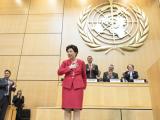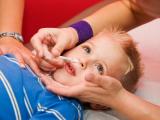Jun 18, 2009 (CIDRAP News) – An analysis of novel H1N1 influenza cases in healthcare workers in the early weeks of the epidemic shows that half of them were probably infected on the job, and most of those weren't using respiratory protection, the Centers for Disease Control and Prevention (CDC) said today.
Among 26 cases for which detailed information was available, 13 of the healthcare personnel (HCP) were believed to have been infected in a healthcare setting, the CDC said. Only three of the infected workers reported using a surgical mask or an N-95 respirator.
The findings suggest that health workers are being infected both at work and in the community and that healthcare facilities need to reinforce messages about current infection control recommendations, the CDC said in the Jun 19 issue of Morbidity and Mortality Weekly Report.
Part of the problem is that potentially infectious patients aren't always being identified as soon as they arrive at a clinical or hospital, so medical workers are not promptly alerted about the need to don protective garb, CDC officials said at a news briefing today.
Exposure factors
The CDC had received reports of 48 novel flu infections in HCP by May 13, and 26 of those included detailed information about possible exposures to the virus. Two of the 26 workers were hospitalized, but none required intensive care, and all recovered.
Six of the 26 workers reported caring for a patient with H1N1 flu, and another six cared for a patient with a respiratory illness, the CDC said. Six workers reported close contact with someone who had the virus or a respiratory illness, and four had traveled recently to Mexico.
Of the 13 personnel judged likely to have been infected at work, 12 probably or possibly caught the virus from a patient, and the other person probably was infected by another healthcare worker, the CDC reported.
As for the other 13 personnel, 11 were believed to have been infected outside work, and the other two had no reported exposures either on or off the job.
Among the 12 people believed to have been infected by patients, 11 gave information on their use of personal protective equipment (PPE) while working. Only three of these reported always using a surgical mask or an N-95 respirator. Five reported always wearing gloves, but none reported consistent use of eye protection. Nor did any worker report always using gloves, gown, and a mask or respirator.
However, the findings do not prove that the workers were infected because they didn't use PPE, the report states.
Infection control recommendations
Because of the lack of a vaccine and limited data on the novel virus's behavior, the CDC currently recommends that at-risk HCP use N-95 respirators, eye protection, and contact precautions, in addition to the usual infection control precautions for seasonal flu, the report notes. The latter include vaccination, isolation of patients in single rooms, and standard and droplet precautions.
Among the barriers to the use of proper infection control precautions, the CDC says, is failure to recognize patients and activities that warrant such precautions. Dr. Michael Bell commented at today's news briefing. He is associate director for infection control in the CDC's Division
of Healthcare and Quality Promotion, National Center for Preparedness, Detection, and Control of Infectious Diseases.
"Probably the single most important thing is that infectious patients be identified at the front door," whether in a hospital or an outpatient clinic, Bell said.
He added later, "One of the patterns we're beginning to see is that healthcare facilities are not promptly identifying potentially infectious patients." In normal circumstances, with no indication that PPE is needed, "there's no way to expect those personnel to do this consistently. That identification of a potentially infectious patient's first step is absolutely essential for this to work."
The number of novel flu infections in people involved in healthcare has grown to 81 since May 13, Bell reported. He said the CDC does not have detailed information on the additional cases, but there are no signs of a "sudden increase or an alarming change in pattern."
"We are not seeing anything to indicate that HCP are overly represented among cases in this country," he added.
The MMWR article says that about 4% of confirmed and probable H1N1 cases in adults up to May 13 were in HCP, whereas about 9% of working adults in the United States work in healthcare.
Disease severity in young people
In other comments at today's briefing, Dr. Daniel Jernigan, deputy director of the CDC's Influenza Division, said the robust immune response of young people may have something to do with the finding that the virus is hitting younger people harder than older groups. Last week Dr. Margaret Chan, head of the World Health Organization, said most of the severe and fatal cases are occurring in people between 30 and 50.
In response to a question, Jernigan noted that older people may have some protection from the virus because of previous exposures to other H1N1 viruses, distant relatives of the new strain.
"In terms of the younger individuals, it may be that the severity of the disease is due to the robust immune response of younger individuals," he added. "But at this point we don't have any specific information to tease that out. But I would say that the serology supports the notion that there may be protection among older individuals, and the severity of the disease, notably in Mexico City, suggests that the robust immune response in the younger may be responsible for the severity."
On another topic, Jernigan said it's too early to tell whether the novel H1N1 viruses will crowd out seasonal flu viruses and become predominant in the southern hemisphere's current flu season. He said the data from some areas suggest that the novel virus is becoming dominant, but some laboratories are testing only for that strain, so the true picture isn't clear. In some other areas where surveillance has been done for a long time, authorities are finding that the novel virus is predominant but that seasonal strains are also circulating, he said.
"Right now we don't have enough information to say that there is a replacement occurring, and at this point we're expecting that there'll be multiple subtypes circulating this fall," he said.
See also:
Transcripts of CDC press briefings on novel H1N1 flu
http://www.cdc.gov/h1n1flu/press/


















